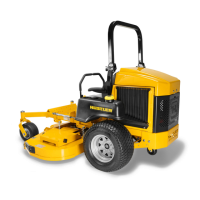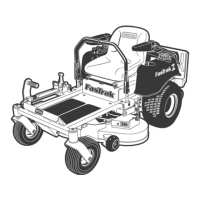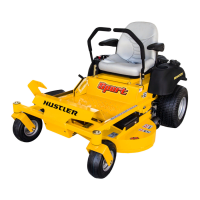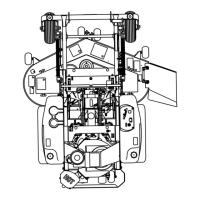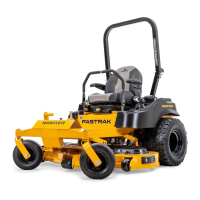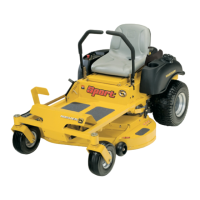608269CE 3-3 REV A
CZ
DA
DE
EN
ES
FR
IT
NL
PT
SV
unseated when the steering control levers are not in the park
brake position (park brake switches are disengaged) or the
deck clutch switch is engaged, the engine will stop.
The following steps are the correct procedures for starting
the engine. If difficulty is encountered, contact the Hustler
®
Dealer in your area.
1. Before starting mower each day, perform daily pre-
operation checking. (See Safety Start Interlock System
section.)
2. Make sure the steering control levers are in the park
brake position and deck clutch switch is disengaged.
Only start the engine from the operator’s position.
3. Use the choke, if the unit is equipped with one, when
engine is cold, or if warm engine fails to start within 5
seconds of cranking. Avoid flooding and operate
engine without choking as soon as possible.
4. Set throttle at approximately 1/2 open position.
5. Insert key in ignition switch and rotate full clockwise
to engage starting motor. Release key when engine
starts.
IMPORTANT: The engine starter should not be
operated for periods longer than 30 seconds at a time.
An interval of at least two minutes should be allowed
between such cranking periods to protect the starter
from overheating and burn-out.
6. Perform test to make sure safety start interlock
system is operating properly. Refer to Safety Start
Interlock System section.
7. Allow the engine to idle a few minutes before
advancing the throttle and/or engaging the deck
clutch.
Stopping the Engine
Use the following procedure to shut the engine off.
1. Place the steering control levers in the park brake
position.
2. Throttle the engine back to low idle, then disengage
the deck clutch. Refer to the Mower Deck Operation
section for more details.
3. Let the engine run at low idle for two minutes.
4. Rotate the ignition key counter-clockwise to the “OFF”
position. Remove the key from the switch before
leaving the mower.
Moving the Mower with Stalled Engine
The bypass valves on the transaxles allow the mower to be
moved if the engine quits working.
Before moving the unit, rotate the bypass valve levers
toward the front of the mower 90 degrees. This places the
bypass valves in the disengaged position. Figure 3-6
Place the steering control levers in the neutral position, to
release the park brakes, so that the mower can be moved.
Do not tow the machine. Move it by hand or use a winch to
load onto a trailer for transporting.
Secure the mower, facing forward, when transporting on
another vehicle. Tie the mower down securely using straps,
chains, cables, or ropes. Both front and rear straps should be
directed down and outward from the machine.
IMPORTANT: Always make certain the two bypass valves
are returned to their operating position before running the
mower following repairs.
Mower Operation
Driving the Mower
After starting the engine, engage the steering control
levers and steer as follows:
To go forward, push the steering control levers forward an
equal distance. Figure 3-7
To go in reverse, pull the steering control levers rearward
an equal distance. Figure 3-7
To turn left, move the right steering control lever farther
forward from neutral than the left steering control lever.
To turn right, move the left steering control lever farther
forward from neutral than the right steering control lever.
Figure 3-7
Bypass valve lever shown in operating position
A. Bypass valve lever
Figure 3-6
Never make sudden stops or reverse direction,
especially when maneuvering on a slope. The
steering is designed for sensitive response. Rapid
movement of the control levers in either direction
could result in a reaction of the mower that can
cause serious injury.
A
DANGER
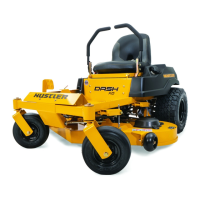
